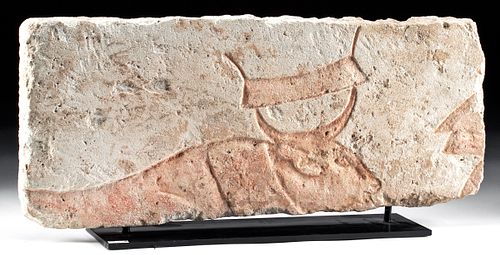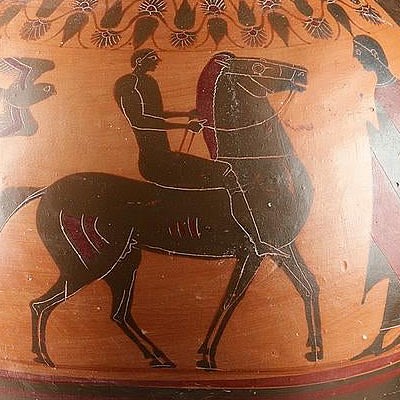Egyptian Armarna Limestone Relief of Ox ex-Royal Athena
Lot 1b
About Seller
Artemis Fine Arts
686 S Taylor Ave, Ste 106
Louisville, CO 80027
United States
Selling antiquities, ancient and ethnographic art online since 1993, Artemis Gallery specializes in Classical Antiquities (Egyptian, Greek, Roman, Near Eastern), Asian, Pre-Columbian, African / Tribal / Oceanographic art. Our extensive inventory includes pottery, stone, metal, wood, glass and textil...Read more
Estimate:
$28,500 - $40,000
Absentee vs Live bid
Two ways to bid:
- Leave a max absentee bid and the platform will bid on your behalf up to your maximum bid during the live auction.
- Bid live during the auction and your bids will be submitted real-time to the auctioneer.
Bid Increments
| Price | Bid Increment |
|---|---|
| $0 | $25 |
| $300 | $50 |
| $1,000 | $100 |
| $2,000 | $250 |
| $5,000 | $500 |
| $10,000 | $1,000 |
| $20,000 | $2,500 |
| $50,000 | $5,000 |
| $100,000 | $10,000 |
| $200,000 | $20,000 |
About Auction
By Artemis Fine Arts
Jun 4, 2020
Set Reminder
2020-06-04 10:00:00
2020-06-04 10:00:00
America/New_York
Bidsquare
Bidsquare : Exceptional Antiquities, Asian, Ethnographic
https://www.bidsquare.com/auctions/artemis-gallery/exceptional-antiquities-asian-ethnographic-5185
An important one-day auction featuring museum-worthy examples of Egyptian, Greek, Roman, Etruscan, Near Eastern, Far East / Asian, Pre-Columbian, African / Tribal, Oceanic, Native American, Spanish Colonial, Russian, Fossils, Ancient Jewelry, Fine Art, so much more! Artemis Fine Arts info@artemisfinearts.com
An important one-day auction featuring museum-worthy examples of Egyptian, Greek, Roman, Etruscan, Near Eastern, Far East / Asian, Pre-Columbian, African / Tribal, Oceanic, Native American, Spanish Colonial, Russian, Fossils, Ancient Jewelry, Fine Art, so much more! Artemis Fine Arts info@artemisfinearts.com
- Lot Description
Ancient Egypt, New Kingdom, Amarna Period, late 18th Dynasty, reign of Amenhotep III and Akhenaten, ca. 1361 to 1336 BCE. A gorgeous fragment of a hand-carved limestone relief panel of a rectangular form with traces of the original chiseling striations across the front. Depicted is the top portion of a muscular bull with a gently sloping back, a broad shoulder, and a slender head that is bowed slightly forward. The single almond-shaped eye, tapered snout, and narrow mouth give a sense of scale for this beast of burden. The gap between each curved horn is bridged by a thick rectangular binding strap that is intended to grow the horns upwards rather than outwards. The shoulder and forearm of the ox's handler are visible along the righthand side of the panel, and pale orange-red pigment within the relief details further accentuates the expert detailing. Size: 20.75" L x 8.75" W (52.7 cm x 22.2 cm)
Oxen were some of the most important animals in ancient Egypt and were used for a variety of tasks including cargo transportation, butchering for meat, and back-breaking agricultural work. They were hearty creatures who were domesticated long before even the Pre-Dynastic periods roughly 6,000 years ago and enabled the cultivation of vast swaths of land for Egypt to live and thrive upon; thus, owning oxen was seen as a great symbol of status and wealth accumulated via their labor. According to scholar Dorothea Arnold, "To own cattle was a sign of high standing for a peasant in ancient Egypt; plow oxen usually had to be rented from a large state or temple institution. Even if the oxen were not actually owned by the plowman, however, an exceptionally strong bond could exist between man and animals. A tale of the New Kingdom tells of a young man who worked on his older brother's farm and lived so closely with the cattle that he could understand their language. When the older brother set out to kill the younger, because the elder's wife - as the wife of Potiphar - had accused the younger brother of trying to seduce her, the cattle warned him in time for him to escape." (Arnold, Dorothea. "An Egyptian Bestiary." The Metropolitan Museum of Art Bulletin, Spring 1995, Vol. LII, no. 4, p. 51)
For a wonderful example of oxen horn bindings from a painted wall within the tomb of Nakht from the 18th Dynasty, please see: Arnold, Dorothea. "An Egyptian Bestiary." The Metropolitan Museum of Art Bulletin, Spring 1995, Vol. LII, no. 4. p. 38.
Provenance: private New York, USA collection, acquired in 2013; ex-private Swiss-American estate collection, New York, New York, USA, acquired in 1990; ex-Royal-Athena Gallery, New York, New York, USA, #1990.BL8701c, BL8702c; ex-private B.L. collection, taken on consignment on owner's behalf in 1987
All items legal to buy/sell under U.S. Statute covering cultural patrimony Code 2600, CHAPTER 14, and are guaranteed to be as described or your money back.
A Certificate of Authenticity will accompany all winning bids.
We ship worldwide and handle all shipping in-house for your convenience.
#152810This is a fragment of a larger limestone relief panel. Nicks and abrasions to ox, handler, front, peripheries, and verso, with light fading to orange-red pigmentation, minor softening to some finer details, and light encrustations. Light earthen deposits throughout, and nice traces of original pigment within carved details.Condition
- Shipping Info
-
All shipping is handled in-house for your convenience. Your invoice from Artemis Gallery will include shipping calculation instructions. If in doubt, please inquire BEFORE bidding for estimated shipping costs for individual items.
-
- Buyer's Premium



 EUR
EUR CAD
CAD AUD
AUD GBP
GBP MXN
MXN HKD
HKD CNY
CNY MYR
MYR SEK
SEK SGD
SGD CHF
CHF THB
THB














